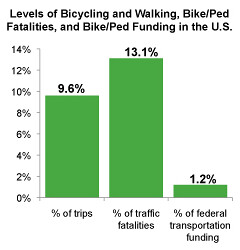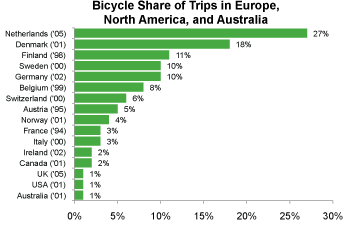Okay, so we know that despite troubles in Detroit and Toyotaland the automobile is still king in the US of A. But sometimes it takes some raw numbers to bring home just how much the entire country’s infrastructure is stacked against non-driving traffic participants.
The Alliance for Biking and Walking just released the 2010 Benchmarking Report on bicycling and walking in the U.S. The 192 page report collected and analyzed data from all fifty states and the 51 largest U.S. cities.
From bicycle and pedestrian staffing levels to bike racks on buses, this report is a tour de force of numbers, data and statistics concerning the millions of trips taken every day by foot or bike. The bottom line though is this: While 9.6% of all trips nationwide are people powered, a mere 1.2% of federal transportation funding is spent on bicycling and walking.
 While funding for bicycle and pedestrian infrastructure has slightly increased over the last two decades, most federal, state and local funding for transportation still goes toward making room for cars. Bicycle and pedestrian advocates are often portrayed as wanting to take over, asking for more than their share when in reality we are light years away from any kind of proportional representation.
While funding for bicycle and pedestrian infrastructure has slightly increased over the last two decades, most federal, state and local funding for transportation still goes toward making room for cars. Bicycle and pedestrian advocates are often portrayed as wanting to take over, asking for more than their share when in reality we are light years away from any kind of proportional representation.
As some prominent members of Congress showed in their reaction to the 2009 American Recovery and Reinvestment Act, the bicycle is not even viewed as a legitimate means of transportation among some members of congress. No wonder that committing $825 million, or 0.3% of the 27.5 billion dollars for highway funds and transportation enhancements to bicycle and pedestrian projects would draw a response like this:
“I think there’s a place for infrastructure, but what kind of infrastructure? Infrastructure to widen highways, to ease congestion for American families? Is it to build some buildings that are necessary?” He stated. “But if we’re talking about beautification projects, or we’re talking about bike paths, Americans are not going to look very kindly on this.”
– Republican House Leader John Boehner on Bikes and Beautification
The results of this chronic neglect of pedestrian and bicycle infrastructure is highlighted in the report:
States with the lowest levels of biking and walking have higher traffic fatalities and chronic disease
The 2010 Benchmarking Report reveals that in almost every state and major U.S. city, bicyclists and pedestrians are at a disproportionate risk of being killed, and receive less than their fair share of transportation dollars.
o~O~o~O~o~O~o~O~o~O~o~O~o~O~o~O~o~O~o~O~o~O~o~O~o~O~o~O~o~O~o~O~o~O~o~O~o
 It’s obviously not fair to hold the U.S. to the same standard as Europe. After all, most European cities were built and evolved long before the advent of the automobile, establishing strong pedestrian and biking infrastructures in very densely populated areas that were never quite as completely wiped out by the automobile as they were in their American counterparts. However, it is quite eye-opening to look at a chart like this one, just to see what’s possible. Interestingly enough, some of these densely populated European countries like Italy and the U.K. are at the bottom of the chart, along with the big new world countries like Australia, Canada, and the U.S. It looks like narrow alleys and old world cobblestone alone don’t do the trick. Likewise, having big wide roads on a square grid may not be sufficient excuse for the lack of people-powered transportation.
It’s obviously not fair to hold the U.S. to the same standard as Europe. After all, most European cities were built and evolved long before the advent of the automobile, establishing strong pedestrian and biking infrastructures in very densely populated areas that were never quite as completely wiped out by the automobile as they were in their American counterparts. However, it is quite eye-opening to look at a chart like this one, just to see what’s possible. Interestingly enough, some of these densely populated European countries like Italy and the U.K. are at the bottom of the chart, along with the big new world countries like Australia, Canada, and the U.S. It looks like narrow alleys and old world cobblestone alone don’t do the trick. Likewise, having big wide roads on a square grid may not be sufficient excuse for the lack of people-powered transportation.
o~O~o~O~o~O~o~O~o~O~o~O~o~O~o~O~o~O~o~O~o~O~o~O~o~O~o~O~o~O~o~O~o~O~o~O~o
 The next chart is an eye-opener if ever there was one. I hate to look at this as only a matter of money and funding. Certainly how you spend your money on improving bike and pedestrian infrastructure is going to have an effect on how many people you can lure out of their cars and onto their hoofs and pedals, but the numbers don’t lie, you get what you pay for, whether you’re in Europe or North America. You roughly get a 1% increase in biker and walker share for each additional dollar spent on bike and pedestrian infrastructure per resident per year. Whether you’re a city planner in Amsterdam or Portland, investing in bike lanes and pedestrian zones seems to be a surefire way to get people to leave their cars at home or not have one in the first place.
The next chart is an eye-opener if ever there was one. I hate to look at this as only a matter of money and funding. Certainly how you spend your money on improving bike and pedestrian infrastructure is going to have an effect on how many people you can lure out of their cars and onto their hoofs and pedals, but the numbers don’t lie, you get what you pay for, whether you’re in Europe or North America. You roughly get a 1% increase in biker and walker share for each additional dollar spent on bike and pedestrian infrastructure per resident per year. Whether you’re a city planner in Amsterdam or Portland, investing in bike lanes and pedestrian zones seems to be a surefire way to get people to leave their cars at home or not have one in the first place.
Despite some of those depressing international rankings for the U.S. there is a lot of reason for optimism. The momentum is going in the right direction. As you can see from the chart, cities like Portland are way ahead of the curve for U.S. standards, and it’s no coincidence: In addition to above average funding it is tireless advocacy work by citizens and dedicated city officials that makes a difference. Same in San Francisco, where 16% of people ride a bicycle regularly and one in every 76 residents (11,000 total) is a member of the SF Bicycle Coalition. Also, while the share of the federal highway fund dedicated to biking and walking is still painfully low, at least there is some acknowledgment in the Recovery Act of the importance of people-powered infrastructure in light of massive problems of congestion, obesity, cost of energy, and climate change.
o~O~o~O~o~O~o~O~o~O~o~O~o~O~o~O~o~O~o~O~o~O~o~O~o~O~o~O~o~O~o~O~o~O~o~O~o
Please check out the just released 2010 Benchmarking Report and show the Alliance for Biking & Walking some love. It really is a tremendous resource not only for government officials, advocates, and those working to promote bicycling and walking, but for anyone interested in connecting dots between things like transportation funding, public health, education, and climate change. As the report concludes:
In these times of high gas prices, a warming climate, increasing traffic congestion, and expanding waistlines, increasing bicycling and walking are goals that are clearly in the public interest. As this report shows, where bicycling and walking levels are higher, obesity, high blood pressure, and diabetes levels are lower. Higher levels of bicycling and walking also coincide with increased bicycle and pedestrian safety and higher levels of physical activity. Increasing bicycling and walking can help solve many of the largest problems facing our nation. As this report indicates, many states and cities are making progress toward promoting safe access for bicyclists and pedestrians, but much more remains to be done.
I’ll leave you with a video I produced for a previous post, Talking the Walk.
[youtube=http://www.youtube.com/watch?v=pfzMtfxdDlk]







Hi Sven — It’s interesting that FINLAND has such a high percentage of bike trips. It’s not like Finland is densely populated, plus they have very harsh weather for a good portion of the year! It really comes down to attitude. And I have a feeling that the states in the US now are going to be becoming a lot more varied than they already are, in a number of different ways… Oregon will probably continue to be a bike haven, whereas Oklahoma probably never will be. But that will help inform our choices about where to live and do business too. It’s already being shown that pedestrian areas are more economically vibrant and resilient in this downturned economy than shopping areas people have to drive to. So things are changing, thankfully. And if Oklahoma doesn’t choose to change their planning patterns and priorities, then economically they’ll be left behind! Anyway, thanks for the great essay and the link to the fabulous informative report. xxooo -Vinessa
Vinessa, I think you’re spot on with your assessment that it will become an economic necessity for people to live closer together and the places that can’t adapt will probably lose population because people won’t be able to afford the long commutes anymore. So on top of being ecologically the right thing to do it’s really smart economics on the part of cities like Portland to invest in bike and pedestrian infrastructure.
Glad you got to see the report, I totally loved it, it’s the kind of thing I like to geek out on, and being such a devoted bike aficionado such as yourself it’s a “must read” 🙂